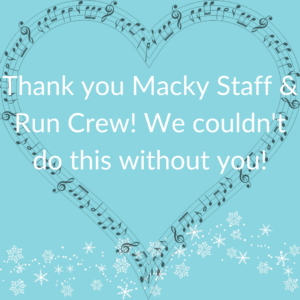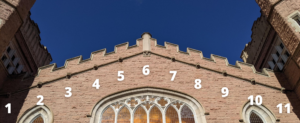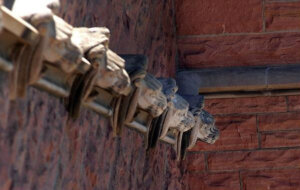The 12 Days of the Holiday Festival
To the tune of “The 12 Days of Christmas” …
🎶 On the first day of the holidays, the CU College of Music gave to me 🎶 the 2021 Holiday Festival! There’s only one, so join us in Macky to kick off the holiday season with this CU Boulder tradition!
If you haven’t yet, click here to buy your tickets!
🎶 On the 2nd day of the Holiday Festival, the College gave to me: 2 choirs performing! 🎶
Click here for more information about the CU Choirs!
🎶 On the 3rd day of the Holiday Festival, the College gave to me: 3 days of performances (which will include fan-favorite “Carol of the Bells in ¾ time)! 🎶
According to ClassicFM:
“‘Carol of the Bells’ is a Ukrainian-American carol. The melody is taken from a Ukrainian folk chant, known since the 20th century as ‘Shchedryk’. And the lyrics are by American composer Peter Wilhousky.
‘Shchedryk’ translates as ‘The Little Swallow’ and before the Christmas lyrics were set, it was originally sung for the new year. It was arranged to tell the story of this little swallow by Ukrainian composer and teacher Mykola Leontovych in 1914.
From fluttering swallows, then, to jingling bells.
The rushing Christmas words Peter Wilhousky penned and set in 1936 make the bell-like opening chords onomatopoeic. The choir intones ‘Ding, dong, ding, dong’ in accompaniment, as ‘silver bells’ indicate ‘Christmas is here’. The Christmassy flurries are twinged with uncertainty, though – evocative, perhaps, of those end-of-the-year feelings and reflections familiar to us all.”
🎶 On the 4th day of the Holiday Festival, the College gave to me: 4 total performances (including a string quartet)! 🎶
The string quartet consists of four string instruments: two violins, a viola, and a cello. It has been the predominant genre of chamber music since about 1750.
The violin is the soprano instrument of the violin family and came into popularity during the 16th century Renaissance, evolving from earlier bowed instruments. It could be argued that the violin is probably one of the best-known and most widely-distributed musical instruments in the world.
According to Britannica: “the violin has a fretless fingerboard. Its strings are hitched to tuning pegs and to a tailpiece passing over a bridge held in place by the pressure of the strings. The bridge transmits the strings’ vibrations to the violin belly, or soundboard, which is made of pine and amplifies the sound. Inside the instrument, beneath the treble foot of the bridge and wedged between the violin belly and back, which is made of maple, is the sound post, a thin stick of pine that transmits the string vibrations to the instrument’s back, contributing to the characteristic violin tone. The belly is supported from beneath by the bass bar, a narrow wood bar running lengthwise and tapering into the belly. It also contributes to the resonance of the instrument. The sidewalls, or ribs, are constructed of pine-lined maple.”
The viola is the tenor instrument of the violin family and likely came into popularity during the 18th century.
According to Britannica: “It is built in proportions similar to those of the violin but has a body length of 37 to 43 cm (14.5 to 17 inches), about 5 cm (2 inches) longer than a violin. Its four strings are tuned c–g–d′–a′, beginning with the C below middle C. The viola’s tone is darker, weightier, and warmer than that of the violin. The modern symphony orchestra contains from 6 to 10 violas. The viola is an integral member of the string quartet and larger chamber music ensembles.
The cello is the bass instrument of the violin family and was developed during the 16th century. Early cellos contained five strings rather than four like modern-day cellos.
According to Britannica: “[the cello has] four strings, pitched C–G–D–A upward from two octaves below middle C. The cello, about 27.5 inches (70 cm) long (47 inches [119 cm] with the neck), has proportionally deeper ribs and a shorter neck than the violin.”
Some famous string quartets include the Takács Quartet, Parker Quartet, Kronos Quartet, and Vitamin String Quartet (featured below).
🎶 On the 5th day of the Holiday Festival, the College gave to me: 5 hours of music (including the five-member Jazz Combo)! 🎶
A jazz combo is a smaller jazz band, typically containing between five and seven musicians. An upright acoustic bass is nearly always present in a jazz combo, but the remaining members can be in almost any combination of instruments and/or vocals. It is more common for jazz combos to play their music entirely from memory, which makes the improvisatory sections more unique to each separate performance.
Some famous jazz combos include the Miles Davis Quintet, the Charlie Parker Quintet, the Art Ensemble of Chicago, The Jazz Messengers, and the Benny Goodman Sextet.
🎶 On the 6th day of the Holiday Festival, the College gave to me: 6 cellos in the CU Symphony Orchestra! 🎶
As mentioned above, the cello gained popularity during the 16th century and is one of the four members of a string quartet. Some famous cellists include Yo-Yo Ma and Steven Sharp Nelson from The Piano Guys (below)!
🎶 On the 7th day of the Holiday Festival, the College gave to me: 7 days of production! 🎶
They began getting ready on Sunday, Nov. 28th and have put together everything you will see at the Holiday Festival! They will also be working the festival. Say thank you to the Macky crew if you see them!

🎶 On the 8th day of the Holiday Festival, the College gave to me: 8 carols in Leroy Anderson’s A Christmas Festival! 🎶
Leroy Anderson bio:
Leroy Anderson was an American conductor, arranger, and composer who was born on June 29, 1908 in Cambridge, Massachusetts. He is perhaps best known for pieces such as A Christmas Festival (arranger) and Sleigh Ride (composer), as well as others. He attended Harvard University where he earned a Bachelor of Arts in German and Scandinavian languages in 1929 and a Master of Arts in Music in 1930. He also conducted the Harvard University Band as a graduate student. Due to his fluency in nine languages, Anderson served as an interpreter during World War II and also served in the army during the Korean War.
Anderson began working with Arthur Fiedler and the Boston Pops Orchestra in 1931 as their arranger, and he submitted his first arrangement, Harvard Songs, to Fiedler in 1936. The Boston Pops performed his first composition, Jazz Pizzicato, in 1938. According to Britannica, “[a] survey by the American Symphony Orchestra League in 1953 determined that among American composers, Anderson’s works were the most frequently performed.”
Anderson was awarded a star on the Hollywood Walk of Fame in 1976 and posthumously to the Songwriters Hall of Fame in 1988. In 1995, Harvard named its new Harvard University Band headquarters the Anderson Band Center to honor him.
Anderson died of cancer on May 18, 1975.
You can read his full bio here.
Program notes for A Christmas Festival:
A Christmas Festival was written by Leroy Anderson and first recorded on October 27, 1952.
When asked why he wrote this piece, Anderson said, “Well, I was trying to write a Christmas festival. You see, there are all types of things that have been written for various occasions and in this particular case I was working at the time for the Boston Pops, I was the arranger and orchestrator for them for years, and they wanted to record a special concert number, using Christmas songs, carols and other Christmas music, for records, so they asked, Arthur Fiedler asked me to do a concert overture, and this is how it came about. I selected the ones that were the most popular and best known, and then I took them and tried to give instrumental treatment to them; in other words, it’s not a medley, that isn’t what we wanted to do here, certainly what I didn’t want to do. I rather took the themes and built you might say a concert overture, around the Christmas songs. They’re not just carols because in this we end with ‘Jingle Bells’, that is, of course, a secular song, it’s not a carol, but it’s associated so much with the gaiety and spirit of Christmas that you certainly couldn’t leave it out.”
A Christmas Festival is a medley of eight carols: Joy to the World, Deck the Halls, God Rest Ye Merry Gentlemen, Good King Wenceslas, Hark! The Herald Angels Sing, Silent Night, Jingle Bells, and O Come All Ye Faithful.
Were you able to name them all in CU Presents’ A Christmas Festival trivia challenge last Friday?
🎶 On the 9th day of the Holiday Festival, the College gave to me: 9 candles on the Macky Auditorium menorah! 🎶
Here are some fun facts about Chanukah!
-
- Chanukah (Hanukkah) is the Jewish Festival of Lights.
- The holiday celebrates the rededication of the Jerusalem Temple following the Maccabean revolt.
- The Maccabees found a tin of oil in their recaptured Temple. The oil was supposed to give light for one night, but lasted for eight.
- Traditionally, there are nine candles on the Chanukah menorah.
- Candles are lit from left to right but added from right to left each evening.
- The center candle is called the shamash and is used to light the other eight candles.
- There are two main Chanukah stories:
- The battle between the Maccabees and the Seleucid King Antiochus.
- The religious miracle of a single tin of oil lasting for eight days.
- Historically Chanukah was a minor holiday, but in recent years it has gained attention as “the Jewish answer to Christmas.”
- Oil symbolizes the miracle of Chanukah, so many traditional foods, such as latkes and sufganiyot, are fried in oil.
🎶 On the 10th day of the Holiday Festival, the College gave to me: 10 run crew members of Macky Auditorium! 🎶
The Macky Auditorium run crew is responsible for:
-
- Mapping the magic projections on the hall architecture
- Designing the lights delighting effects
- Making sure everything sounds balanced and great
- Setting up the stage
- Building extra stage space and putting a piano on top of it with magic
- Making sure everyone is comfortable backstage
- Making sure the elves behave
- Putting everything away after the festival

🎶 On the 11th day of the Holiday Festival, the College gave to me: 11 architectural ornaments at the top of the Macky façade! 🎶


🎶 On the 12th day of the Holiday Festival, the College gave to me: 12 days of the Holiday Festival! 🎶
Thank you all for joining us on our countdown! We look forward to seeing you all at the Holiday Festival this weekend!